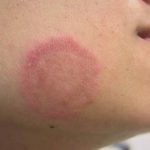Ringworm(Dermatophytosis): Causes, Symptoms, Diagnosis, Treatment, Prevention.
WHAT IS RINGWORM?
Also known as tinea infection, it is a fungal infection of the skin, scalp or nails. It is also called dermatophytosis.
Ringworm is a misnomer, since a fungus, not a worm, causes the infection. The lesion caused by this infection resembles a worm in the shape of a ring — hence the name.
CAUSES
Ringworm is caused by various types of fungi known as the dermatophytes.
It is spread by direct contact with an infected person or animal (dogs, cats, guinea-pigs, cattle), contact with soil or by indirect contact with items contaminated by the fungus, for example clothing, towels, bedclothes, chairs, and toilet articles handled by people with the infection.
The link with water is via poor personal domestic hygiene and shortage of water for cleaning and washing.
COMMON TYPES
The different types of dermatophytosis are:
- Ringworm of the scalp (tinea capitis) often starts as isolated scaling in the scalp that develop into itchy, scaly bald patches. It’s most common among children.
- Ringworm of the body (tinea corporis) often appears as patches with the characteristic round ring shape.
- Jock itch (tinea cruris) refers to ringworm infection of the skin around the groin,scrotum, inner thighs, and buttocks. It’s most common in men and adolescent boys.
- Athlete’s foot (tinea pedis) is the common name for ringworm infection of the foot. It’s frequently seen in people who go barefoot in public places where the infection can spread, such as locker rooms, showers, and swimming pools.
- Nail (tinea unguium): An infection of the finger or toe nail, characterized by a thickened, deformed nail.
- Intertrigo: found under the breast especially in obese and overweight women.

SYMPTOMS
Symptoms vary depending on where you’re infected. With a skin infection, you may experience the following:
- Red, itchy, scaly, or raised patches
- Itchiness
- Patches that develop blisters or begin to ooze
- Patches that may be redder on the outside edges or resemble a ring
- Patches with edges that are defined and raised
- Painful patches if it become secondarily infected with bacteria
- Baldness for ringworm of the scalp
If you’re experiencing dermatophytosis in your nails, they may become thicker, discolored, or begin to crack. If the scalp is affected, bald patches may develop.
DIAGNOSIS
Your doctor will diagnose ringworm by examining your skin and possibly carry out some tests e.g wood’s lamp examination, skin biopsy, fungal culture, KOH exam.
TREATMENT
Specific treatment for ringworm will be determined by your physician based on:
- your age, overall health, and medical history
- extent of the condition
- location of the ringworm
- your tolerance for specific medications, procedures, or therapies
- expectations for the course of the condition
- your opinion or preference
Treatment for scalp ringworm (tinea capitis) may include an oral anti-fungal medication that is usually prescribed for four to eight weeks.
Some people require longer treatment. Treatment for scalp ringworm may also involve the use of a special shampoo, to help eliminate the fungus. Topical steroids may also be prescribed.
Treatment for ringworm of the body, groin, and foot is usually a topical anti-fungal agent or an oral antifungal medication. The length of the treatment depends on the location of the ringworm.
Because the fungi can live indefinitely on the skin, recurrences of ringworm are likely. Treatment may need to be repeated.
Home Remedy
Pending when you see your doctor, application of over-the-counter antifungal medications like tydineal creams, lamisil cream, terbinafine cream, and Funbact A may prove very effective.
Oral tablets known as Loratidine taken once or twice daily will help reduce the itchiness. Antibiotics may be prescribed to help treat the secondary bacterial infection.
For scalp ringworm, shaving off the entire hair may be therapeutic.
HOME CARE
In addition to prescription and over-the-counter medication, your doctor may recommend that you care for your infection at home by practicing some of the following behaviours, including:
- Avoiding clothing that irritates the infected area
- Washing bedding and clothes daily during an infection
- Cleaning and drying your skin regularly
- Shave of your hair
If you have been scratching your skin frequently due to the infection, you may also develop a staph or strep infection of the skin. Your doctor may prescribe antibiotics to treat this bacterial infection as you continue your treatment for the ringworm.
PREVENTION
You can prevent ringworm by practicing healthy and hygienic behaviours.
Many infections come from contact with animals and lack of proper hygiene.
Remember to wash your hands after interacting with an animal.
If you have a pet, keep its living areas clean and disinfected.
If you have a weak immune system, avoid any animal or individuals who are suspected of having dermatophytosis.
In terms of personal care, take your bath regularly, at least twice daily.
Wear shoes if you shower in community areas.
Avoid sharing personal items such as clothing or comb as these can carry infective spores.
Be sure to keep your feet and skin clean and dry.
Sources
https://www.who.int/water_sanitation_health/diseases-risks/diseases/ringworm/en/
https://www.healthline.com/health/ringworm#vs-eczema
http://www.unthenugu.com.ng/condition_treatment/infectious_disease/Tinea_Infections.html
https://www.nigeriagalleria.com/Community-Health/Ringworm.html
Image Credit: ThinkLink
This article was written by:
ODEMUYIWA ADEYEMI J (MBBS, Ibadan)





















